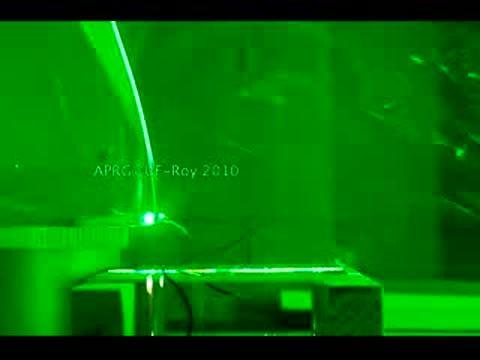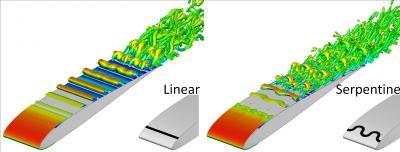Plasmas are a soup of charged particles in an electric field.
While most commonly a part of lightning bolts and stars, the use of high voltage equipment has more practically meant very small plasmas can be used to manipulate fluid flows. Plasma actuators have advanced the promise of controlling flows in new ways that increase lift, reduce drag and improve aerodynamic efficiencies, which may lead to safer, more efficient and more quiet land and air vehicles in the near future.
Unlike other flow control devices, plasma actuator geometries can be easily modified. Enter the serpentine shape, courtesy of the Applied Physics Research Group (APRG), a University of Florida research team in Gainesville that has been developing this and other types of novel plasma actuators for several years.

Entrainment of incense from still air into the flow induced by a serpentine plasma actuator. Credit: R. Durscher, APRG
The serpentine's sinuous, ribbon-like curves appear to impart greater levels of versatility than traditional geometries used in plasma flow control devices, according to Mark Riherd, a doctoral candidate working under Subrata Roy, the founding director of APRG.
"Our serpentine device will have applications in reducing drag-related fuel costs for an automobile or an aircraft, minimizing the noise generated when flying over populated areas, mixing air-fuel mixtures for lean combustion, and enhancing heat transfer by generating local turbulence," Riherd said.

Comparison of turbulent flow structures over an airfoil when a pulsed linear (left) and a serpentine (right) plasma actuator are used to control the flow. Credit: M. Riherd, APRG
In a report appearing in the Journal of Applied Physics, which is produced by AIP Publishing, the team validated the complex, three-dimensional flow structures induced by their serpentine plasma actuators by comparing numerical results with recent physical experiments in non-moving air. They then simulated the effects of the actuators in a non-turbulent boundary layer and over a small aircraft wing. Further tests are needed, but early results suggest serpentine flow wrangling may improve transportation efficiencies.
"This may result in significant weight and fuel savings for future aircraft and automobiles, improving energy efficiency all around," Riherd said.





Comments